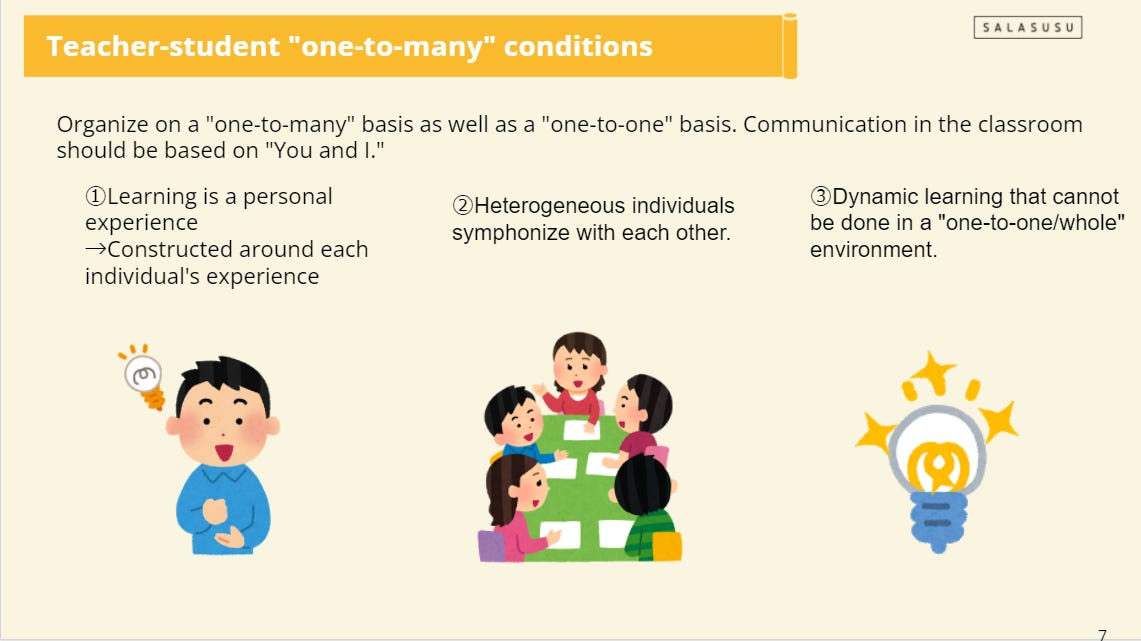What is "Ideal Lessons"? How should Lesson Study be Conducted?
Reflective Lesson Study Enables Every Student to Learn Effectively
SALASUSU aims to help each student learn better by training instructors who are not traditional teachers who are teaching a skill or particular level of knowledge, but rather facilitators who are (1) ensuring students' psychological safety, (2) ensuring that everyone can learn, and (3) are reflective of the process as a whole.
In order to develop the skills of such instructors, we have conducted the TOT (Training of Trainer) program. Since it is difficult to develop facilitation skills in a TOT manner of teaching, we have mainly implemented TOT, where workshops and training are already being conducted. However, since the training was only temporary, lasting about three days, and held only three times, we felt that it was difficult to reach the desired transformation of the mindset in the trainers. Therefore, we are considering incorporating "Lesson Study" as a means to strengthen trainers' abilities on a regular basis.
Currently, we are in the process of researching the development of lesson studies with advice from field experts. In this article, it will be explained how classes and lesson study should be conducted using diagrams based mainly on information obtained from "Introduction to lesson study" (1996: Tadahiko Inagaki and Manabu Sato)[1].
Three Aspects of Teaching
Classroom teaching is generally regarded as a "cognitive practice" that forms knowledge and skills. However, it is also a complex process that consists of three individual aspects. Other than "cognitive practices," the other two aspects are the "social practices" and "ethical practices." "Social practices" refers to the relationships among the students and teachers who make up the classroom. "Ethical practices" reflect on one's ideas and integrate one's own identity into the classroom.
The Classroom
It has often been considered a reliable practice to teach in an efficient and orderly manner in the traditional communicative classroom. In this book, such teaching is referred to as "one-to-whole."
In the new inquiry-based, student-centered classroom, however, the goal is to create a classroom composed of the diverse personalities of the teacher and each student. They call such classes "one-to-many." One-to-many classrooms have three conditions, as shown in the figure below. It is important that each student's learning is actually occurring in the classroom and that they are not just transmitting knowledge.
From Technical Practice to Reflective Practice
In the traditional communicative teaching style of "one-to-whole," the classes that fell under "technical practices" developed as a "visible practice" of questioning and instructional techniques. "Technical practices" are based on the "scientific principles" of programs and classroom techniques and hence can be observed. The idea here is that a solid curriculum and strong teaching techniques produce quality classes as well.
On the other hand, in order to put "one-to-many" into practice and create opportunities for learning for each individual, the class must be a "reflective practice" that develops as an "invisible practice" of discovery, choice, and judgment that occurs dependent by the teacher. "Reflective practice" is based on "practical insights" that are cultivated by the teacher's experience and perception. Unlike "technical practices," there is no single correct answer, and the lesson is developed and adapts according to the situation in the classroom.
What is Practical Insight?
What is Practical Insight?
So what is practical insight, and is it developed as an "invisible practice?" Sato et al. (1991) attributes the following five types of thinking found in skilled teachers as traits of practical insight. [1,2]
(1) Improvised thinking: Impromptu thinking and adaptability in the classroom.
(2) Situational thinking: Mindful engagement during uncertain situations and having a proactive attitude towards problems as they arise
(3) Pluralistic thinking: Synthesis of multiple perspectives in the representation and solution of practical problems. This is also seen as being able to think from the perspective of the various students in the classroom.
(4) Contextual thinking: Constructing the interrelationship of problematic events that occur in an occurring situation in accordance with the situation. To be able to relate and make sense of various facts and events in the classroom as the situation plays out.
5) Reconstruction of thinking: Thinking that constantly reconstructs problems as the class grows and develops. The teacher can relativize, reflect on, and reconfigure their views and opinions.
Lesson Study to Cultivate Practical Insights
How can we develop practical insights?
Traditional lesson study is oriented largely towards "technical practices" and thus is research that explores general technical principles that can be applied in any classroom.
On the other hand, lesson study to develop practical thinking styles is conducted through case studies, examining the meaning of the activities and experiences of teachers and individual students in a single classroom.
Domain of the Lesson Study
The domain of lesson study is constructed of a combination of four key relationships in the class: teacher, child, materials, and learning environment.
Since all of these are intricately related to each other, lesson study is a very sophisticated study. However, in reality, the actual lesson study will focus on only a few elements.
The Process of Lesson Study
Lesson study for reflective practice consists of three stages: 1) Observation and recording, 2) Description and analysis, and 3) Reflection and critique.
Observation and Recording
Video, recorder, and notes are typically used to record. Video is commonly used because it vividly records the visible atmosphere of the classroom and the behavior of the teacher and students, making it highly valuable. However, since only visible practices are recorded, it is useful to combine video recording with the recording of the teacher's narrative. The teacher's narrative record describes the internal process of the class, such as the teacher's interaction with the students, feelings about the material, and reflections on oneself.
The narrative record allows the observers of the lesson study to understand the classroom background and provides an opportunity for the teacher to reflect.
Description and Analysis
Creating a record of the practice and its analysis and observation notes. In the traditional lesson study of scientific and technical practices, it is common to write the teacher as "T" and the students as "C." However, in reflective practices, the meaning of a single lesson is explored, so in the description, the teacher must appear in the first person, and the children must appear under their proper names. In addition, the analysis must examine not only the cause-and-effect relationship between events but also the relationship between the meanings of events.
Reflection and Critique
This phase is the center of lesson study. Through reflection and critique, the class teacher and the observer exchange and share their mutually reflected findings and related experiences, and form new views and ideas through discussion.
It is important that the class review meeting is a place where teachers can learn and grow together through the facts of specific cases, rather than criticizing and arguing in search of one right answer. It should also be a community where teachers can share the depth and difficulty of teaching as well as the satisfaction that comes from it.
Conclusion
In order to provide opportunities where learning can take place on an individual level as well as for learners to be able to transmit knowledge, it is desirable to have classes as "reflective practices" based on "practical insights" cultivated by teachers' experiences and perceptions. The best way to cultivate practical insights is to conduct lesson studies through case studies that explore the meaning of a particular lesson.
However, there are various issues to be considered in practice, such as teachers' understanding of and commitment to lesson study.
In future articles, we would like to discuss the details of the actual lesson study conducted at SALASUSU and the lessons learned, as well as further insights and practices of lesson study by researchers.
References
1. Inagaki, T. and Manabu Sato. Inagaki, T., Sato, M.: Introduction to Lesson Study on Children and Education. 1996, Iwanami Shoten.
2. Inagaki, T., Sato, M., Iwakawa, N., and Akita, Kiyomi. A Study of Teachers' Practical Thinking Style (1): Focusing on the Comparison of Monitoring between Skilled and Novice Teachers. Bulletin of the Faculty of Education, University of Tokyo, 1991; 30: 177-198. https://doi.org/10.15083/00029775






